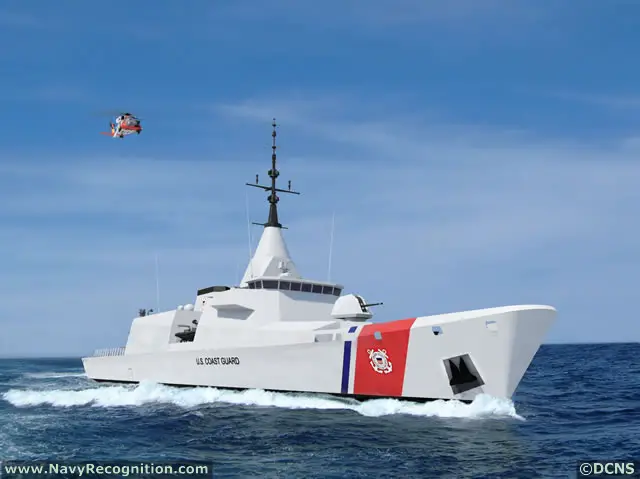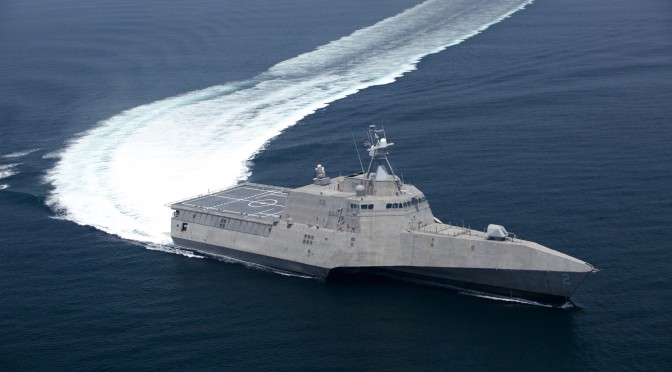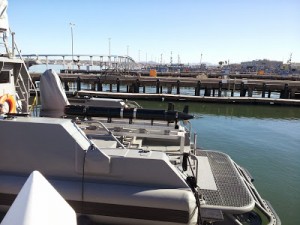The US Coast Guard is currently in the first part or a two part program to select a design for a planned class of 25 ships referred to as Offshore Patrol Cutters (OPC) also called the Maritime Security Cutter, Medium (WMSM). In many respects these might be thought of a third class of Littoral Combat Ships. They have different characteristics and different strengths and weaknesses, but there is considerable overlap in there characteristics. Like the LCS they will be small, shallow draft, helicopter equipped warships with the 57mm Mk110 gun. It seems likely the OPC will be 2,500 to 3,500 tons, similar in size to the Freedom and Independence class LCS.

The only information we have on Huntington Ingalls’ concept for the OPC is this photo tacked onto the end of a DefenseNews.Com report.
The existing LCS classes emphasize adaptability, are faster and have more spacious aviation facilities. The cutters will emphasize seakeeping and will:
- have greater range (minimum 7,500 miles @14 knots) and endurance using all diesel propulsion. Typical operations as outlined in the Concept of Operations (CONOPS) were 14 days between refueling, 21 days between replenishment, and 45-60 day patrols.
- be ice-strengthened,
- have ballistic protection over critical areas,
- have a larger crew, and
- be able to operate their boats and aircraft in higher sea states (through sea state 5).

Illustration from Bollinger Shipyards
The acquisition process:
A two step Acquisition process is being used. First, up to three contractors will be selected to develop their concepts into fully detailed contract proposals. This selection is expected by the end of the second quarter of FY2014. These three will then compete for a contract which will include all documentation, construction of the first OPC (expected delivery in FY2020) and options for up to ten follow-on ships.
Eight yards have submitted bids:
- Bollinger Shipyards, Lockport, La.
- Eastern Shipbuilding, Panama City, Fla.
- General Dynamics Bath Iron Works, Bath, Maine
- General Dynamics Nassco, San Diego
- Huntington Ingalls Industries, Pascagoula, Miss.
- Marinette Marine, Marinette, Wis.
- Vigor Shipyards, Seattle; and
- VT Halter Marine, Pascagoula, Miss.
There has been international interest in the project. VT Halter has partnered with French Defense Contractor DCNS. Vigor is allied with Ulstein, Bollinger is working with Dutch Ship builder Damen. It appears Eastern may have teamed with STX (supposition on my part, based only on their concept‘s similarity to the New Zealand Navy’s Protector Class OPV.

An early DCNS concept
The funding schedule is expected to look like this:
- FY 2016 Detail Design
- FY 2017 OPC #1 Construction
- FY 2018 OPC #2
- FY 2019 OPC #3
- FY 2020 OPC #4 and #5
- FY 2021 OPC #6 and #7
- FY 2022 OPC #8 and #9
- FY 2023 OPC #10 and #11
There was also a statement of intent to hold the maximum price of units four through nine to $310M each.
Specifications:
The ships are to be built to modified American Bureau of Shipping Naval Ship Rules excluding explosive or underwater shock hardening.
They are expected to operate in cold climates. They will be equipped “to operate in areas of broken plate, pancake, and sea ice ranging from 10 to 30 inches thick.” There is also a required capability to operate an ice capable small boat and to have automated topside de-icers.
“The WMSM will provide increased protection for (sic.) small caliber weapons and shrapnel fragmentation around the bridge, CIC, and magazine spaces.”
It will tow up to 10,000 tons.
The ships are expected to be able to do Fueling at Sea (FAS), Replenishment at Sea (RAS), Vertical (Helicopter) Replenishment or VERTREP, and to refuel smaller vessels (apparently reflecting an expectation of sustained operations with smaller patrol vessels (WPCs or WPBs) at locations remote from their bases).
I did not have access to the latest specifications, but have deduced some details of the proposed equipment from the Allowance Equipage List included in the Draft RFP. All the systems below are referenced. (In a few cases there may be duplicate listing if different nomenclature is used for the same system.) The outfit, in most respects, repeats or even improves on that of the National Security Cutter:
Communications:
- Military SAT com
- Tactical Data Link System
- IFF
- SBU (presumably “Sensitive but Unclassified”) Network
- SIPRNET (Classified Network)
- NIPRNET (Unclassified Network)
- Entertainment System
Sensors:
- TSR-3D RARAD System, a multimode surface and air surveillance and target acquisition radar
- Electro-Optic/Infrared Sensor system
- RADIAC
Weapons:
- Mk 48 mod 1 Gun Weapon System (pdf), which includes the Mk 110 57mm gun, AN/SPQ-9B Surface search and Fire Control Radar, Electro-Optical sensor system Mk 20 mod 0, the Mk 160 GCS Mod 12, and Mk 12 Gun Computer System
- Mk 15 mod 21-25 CIWS (Phalanx) (apparently equipped for but not with)
- Mk 38 mod 2 25 mm
- Gun Weapon System SSAM (remotely controlled stabilized .50 cal)
- Four crew served .50 mounts including Mk 16 and Mk 93 mod 0 or mod 4 mounts
- Mk 46 optical sight
Electronic Warfare:
- Mk 53 Decoy launcher
- AN/SLQ-32 (v)2
Navigation:
- Encrypted GPS
- Electronic Chart Display and Information System
Intelligence:
- Ships Signals Exploitation Space
- Special Purpose Intel System
Aviation:
- Hangar for helicopter up to and including Navy and Coast Guard H-60s (There may have been some backtracking on the requirement for a helicopter larger than the HH-65)
- Facilities for the support of unmanned Aerial Systems (UAS)
- TACAN
- Visual Landing Aids

Coast Guard HH-65 Dolphins
Unresolved
Having watched this program develop over a number of years, it is remarkable that the specifications have moved from specific to general as the need to minimize cost has resulted in softening of the requirements. As with many contracts, threshold and objective characteristics were defined, but if there are incentives for going beyond threshold requirements, they have not been made public. For this reason there seems little reason to expect the capabilities to exceed the threshold requirement which include a speed of 22 knots (objective 25).
The aviation support requirements also seem to have gone soft and may result in the ability to support only smaller helicopters and UAVs
Potential Naval Roles
Weapons–A minimal projected fit has been identified, but the Commandant has stated that the ships will have space and weight reservation for additional weapons, but I have not been privy to the extent of this reservation. It may be limited to replacing the Mk38mod2 with a Phalanx, but there is reason to hope the ships have greater potential.
The ships do have an unusual specification. For the Alien Migrant Interdiction Operations, they are required to be able to feed and provide basic shelter for up to 500 migrants for 48 hours, all while keeping them on the main deck or above. This actually constitutes a substantial weight/moment reserve for other missions. If we assumed 150 pounds for each person, that would equate to 37.5 tons.
Modules–While there was apparently no stated requirement to host mission modules or containers in the specifications, some of the foreign designed potential contenders may already include provision for taking containers. For instance, the Damen designed OPV 2600 (ton) has provision for five 20 foot containers. Others may use containers as part of their plan to meet the 500 Alien Migrant holding requirement.

Vigor concept with its Ulstein X-bow. It was reported to have a length of 328 feet, a beam of 54 feet, a draft of 16.5 feet, and a max speed of 22knots. It included a reconfigurable boat hangar.
Manning:
The Coast Guard’s latest Manpower Estimate for the Offshore Patrol Cutters (OPCs), completed 18 March 2011, was 104 (15 officers, 9 CPOs, 80 E-6 and below) plus an aviation detachment (five personnel) and Ship’s Signals Exploitation Space (SSES) detachment (seven personnel) for a total of 116. Accommodations are planned for at least 120 (threshold requirement) and hopefully as many as 126 (“objective”). The manning assumes four section underway watches.
Unlike the two current LCS classes, the OPCs are expected to train junior personnel: “The Coast Guard depends on cutters to expose our junior personnel, officers and enlisted, to our wide mission set. With this real world experience derived from a first tour operational assignment, these sailors populate critical billets such as law enforcement detachments, independent duty corpsmen, and XOs on patrol boats.”
These ships, like the LCS are expected to have multiple crews, with four crews for a group of three ships, allowing them to operate up to 225-230 days away from home port per year. (I personally don’t like the concept as proposed)
Survivability: The preliminary manning documents assumes that two full Repair Lockers (27 crew members in each locker) plus a Rapid Response Team (RRT) will be constituted for General Emergency Situations, but only one full Repair Locker and the RRT will be available at General Quarters. Two engine rooms will provide a degree of propulsion redundancy.
LCS Council:
The CNO saw the need for high level coordination of the introduction of the LCS to insure that they made the most of their potential. Since established they have added oversight of the Joint High Speed Vessels.
I see a need for the Coast Guard to also have a seat the Council to
- share experiences with multiple crewing and other lessons learned
- maximize the wartime potential of the Offshore Patrol Cutters by exploiting commonality with the LCS
- ease coordination of Navy’s LCS and JHSVs partnership station, drug interdiction, and constabulary efforts which often involving Coast Guard detachments.
LCS 2.0, or a Missed opportunity?:
I keep hearing that many, including former undersecretary Bob Work, may not be entirely happy with the characteristics of the existing LCS designs, but that because they are the design we have, we should continue to build them. I have hoped that the Offshore Patrol Cutters would offer a possible alternative for an LCS 2.0. It may be that cost considerations and program choices will make them unsuitable, but at the very least, the eight design proposals and the three fully developed contract proposals should make interesting reading for those who would like to consider alternatives to the existing designs.
In addition, these ships, or designs developed from them, may offer a cheaper alternative basis upon which to offer our allies interested in American built corvettes or OPVs.
If I had my druthers:
If I had my druthers these ships would be designed, but not necessarily equipped, from the start, for wartime roles including ASW and NSFS.
Background: “What might Coast Guard cutters do in wartime.”
Chuck Hill blogs at http://chuckhillscgblog.net/. He retired from the Coast Guard after 22 years service. Assignments included four ships, Rescue Coordination Center New Orleans, CG HQ, Fleet Training Group San Diego, Naval War College, and Maritime Defense Zone Pacific/Pacific Area Ops/Readiness/Plans. Along the way he became the first Coast Guard officer to complete the Tactical Action Officer (TAO) course and also completed the Naval Control of Shipping course. He has had a life long interest in naval ships and history.











